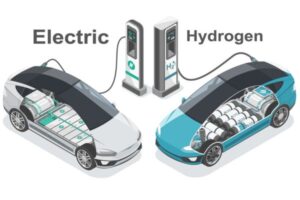GS-3: Environment, Energy, Infrastructure

Key Points:
- PM2.5 pollution caused ~30,000 annual deaths in Indian cities (2008-2019).
- Global EV adoption is rising, led by Europe and China.
- Hydrogen fuel cell vehicles (HFCVs) are 20-30% costlier than battery EVs, but costs may align by 2030.
- Per km costs: HFC buses ($0.84/km) vs. EV buses ($0.17/km), favoring EVs for mass transit.
- Urban air quality crises drive the shift to low-emission transport.
In-Depth Analysis:
- Public Health: Urbanization worsens air pollution, with PM2.5-linked deaths in cities like Mumbai and Delhi. Clean transport is critical.
- Cost Analysis:
- Initial Costs: Hydrogen vehicles are pricier than battery EVs, though costs are declining.
- Operational Costs: EV buses ($0.17/km) are far cheaper than HFC buses ($0.84/km).
- Market Trends:
- Global EV sales projected at 20 million by 2024; India lags at 0.6 million.
- Indian cities like Delhi are adopting EV-based public transport.
- Hydrogen Use Cases: Best suited for long-haul, heavy-duty transport due to fast refueling, but infrastructure is limited.
Technical Concepts:
- PM2.5 Pollution: Fine particles causing health issues.
- Battery EVs (BEVs): Vehicles powered by lithium-ion batteries.
- Hydrogen Fuel Cell Vehicles (HFCVs): Produce electricity from hydrogen, emitting only water.
Importance:
- Battery EVs are currently the most cost-effective clean transport option.
- Hydrogen is promising for long-haul transport but requires technological and policy support.
- India must balance health, cost, and energy needs in its clean transport strategy.




